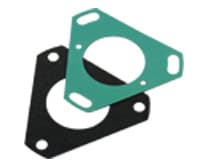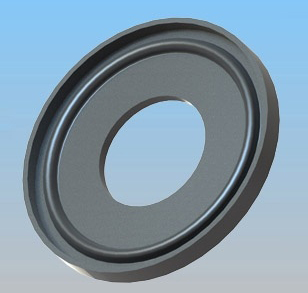What is a Gasket?
What is a Gasket and how it works?
What is a Gasket?
A Gasket is an elastomeric component that covers the intersection between two surfaces. They are usually manufactured from a variety of materials, including rubber, cork or paper, metal, copper, and foam. This flexible element can be used for a broad scope of purposes due to its functionality. These include anti-vibration, packaging, hygiene, noise and sound reduction, and most importantly, its most common use, sealing.
Gaskets are used in virtually all industries, including Food Processing, Petrochemical, Pharmaceutical, Water and Gas. Gasket materials are chosen for their characteristics and capability to withstand a number of environments such as mining and deep sea, resistance to chemicals, alkaline acids, extreme temperatures, and pressure.
What is a Gasket: How does a Gasket function?
For a gasket to function effectively and seal away any leaks, it must be compressed adequately to generate an entire barrier that will make a seal that is pressure-tight and protect the contents inside the seal. Additionally, gaskets protect moving parts of an application by separating them from rubbing against hard surfaces and creating friction. An elastomeric gasket is a component that seals against the release or inlet of both gases and liquids, creating a seal between two surfaces. They are ideal for filling deformities and connecting two surfaces together. Due to the fact that a gasket will fill the space between these two surfaces, they must be manufactured from a material that is easily deformed and adequately fills any irregularities. Frequently, compounds such as spiral wound gaskets are manufactured from a mix of metallic and softer filler material (flexible graphite). In order to seal precisely, metal gaskets must most of the time be compressed at a higher stress. Also, in some cases, a sealant must be applied right on the gasket in order to secure a leak-free seal.
Gasket Applications
A gasket is a crucial element in many manufacturing processes, as they are obtainable in numerous specifications. Gasket material is chosen for an installation on the basis of the features of the material, such as its resistance to chemicals, temperatures (or temperature fluctuations), pressures, acids, gases, and sometimes electromagnetic or electrical forces. Gaskets are very common components and can be found in cars, trains, planes, boats, electrical equipment, pumps, and many more applications.
Gasket Materials
Gaskets are manufactured to suit the application / machine and offer resistance to specific environments. For example, this can be extreme heat or chemical reactions. Popular gasket materials include Perfluoroelastomer (FFKM), Nitrile (NBR), Hydrogenated Nitrile (HNBR), Viton™ (or FKM/FPM), Viton™ A, Viton™ B, Viton™ GF, Viton™ GLT, Viton™ GFLT, Viton™ ETP, Ethylene Propylene (EPDM), Silicone (VMQ), Polytetrafluoroethylene (PTFE) Fluorosilicone (FVMQ) and Medical Grade.
Industries that use gaskets
A gasket material provides the capacity to resist some of the most difficult environments for industrial sealing products, these include:
They also offer sanitary sealing solutions and are extensively used in:
Types of Gaskets
Click on the links below for information on some specific Gasket products:
- Automotive Gaskets
- Armco Iron Gaskets
- Camlock Gaskets
- Compressor Gaskets
- EGR Valve Gaskets
- FDA Gaskets
- Gasket Sealants
- Gland Packing / Compression Packing
- IDF Gaskets
- Manway Gaskets
- Pipeline Flange Gaskets
- PTFE Joint Sealant Tape
- Spiral Wound Gaskets
If you would like more information about our range visit the Gaskets home page, download our catalogue or contact a member of the team.
E & OE. M Barnwell Services endeavours to make sure that all content is correct. Information has been gained from manufacturing partners.



